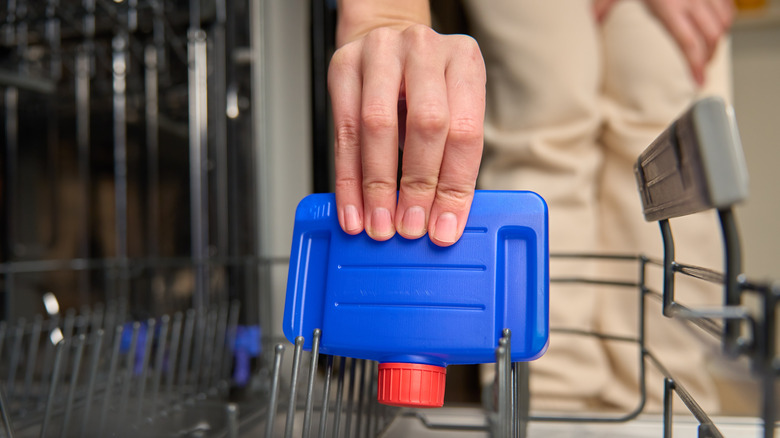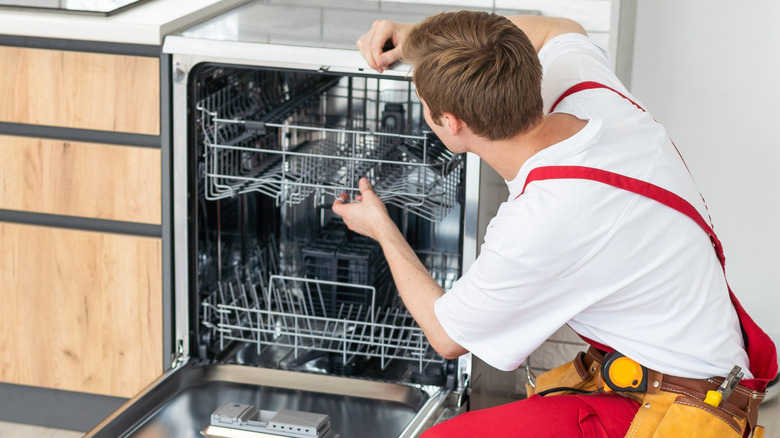Troubleshooting Tips For A Dishwasher That's Not Cleaning Well
When your dishes start coming out of the dishwasher cloudy or nearly as dirty as when they went in, it's time to do some troubleshooting. With dishwashers, though, it can be tough to narrow down the potential problems. Michael Cornell, an Asurion Appliance Expert, told House Digest in an exclusive interview that the culprit can be anything from a clogged spray arm to inadequate water temperature to a faulty detergent dispenser. It can even be human error — yes, it matters how you load the dishwasher. "Placing dishes too closely together or blocking spray arms with large items can restrict water flow, leading to unsatisfactory cleaning," Cornell explained. If that's the problem, learn the ways to use your dishwasher better.
Generally, finding the cause of a malfunctioning dishwasher will take some detective work. Some problems may be more obvious and easier to assess than others. "Using the wrong type of detergent or a malfunctioning dispenser can lead to detergent not being released correctly during the cycle," said Cornell. If your dispenser isn't opening, the problem will be obvious. The dispenser will be closed and your soap will still be in there when the wash cycle is over. If you change the soap and your problem stops, you have likely located the issue. However, if the fix isn't this easy, you will have to start going down the list of possible causes.
Locating the problem with your dishwasher
You've determined that the problem with your dishwasher isn't human error, or the soap you're using. What's next? Take a look at the spray arms. "Debris stuck in these components can block water jets, preventing thorough cleaning," Michael Cornell explained. Unscrew the arms and examine the nozzles. "Use a toothpick or a small brush to clear any blockages," Cornell exclusively told House Digest. Even if this turns out not to be the problem, be sure to regularly clean the spray arms which will help the machine's overall performance.
If this does not solve your problem, move on to the filter. This should be cleaned about once a month, according to our expert, but many homeowners are not doing so. "Locate the filter, usually at the bottom of the dishwasher, and remove it according to the manual instructions," said Cornell. "Rinse it under warm water, using a soft brush to remove stubborn debris." Replace the filter and check your dishes after the next wash cycle.
The next option is to consider your water. "Hard water can lead to mineral deposits on dishes and inside the dishwasher, affecting cleaning," Cornell explained. The solution is to clean the dishwasher itself. To address this, learn how to clean your dishwasher. Alternatively, the water temperature could be an issue. "The ideal temperature is at least [120 degrees Fahrenheit] to ensure that grease and food particles are effectively broken down," Cornell stated. Running your kitchen tap until the water gets hot, and then starting your dishwasher can help.
When it's time to consult a professional
If you have tried all of the above and your dishes still aren't coming out clean, you could have a bigger problem. If that's the case, it may be time to call in an expert. "Problems with essential components like the heating element or water inlet valve should be addressed by a technician," advised Michael Cornell.
If your problems have gone beyond dirty dishes, and you're experiencing other issues with your dishwasher, then there will be obvious signs. "Error codes or a dishwasher that won't start can indicate electronic faults or major mechanical failures needing expert attention," Cornell exclusively told House Digest. Alternatively, you may run into another set of problems. "Unusual sounds or leaks may indicate issues with the pump, motor, or door gasket, requiring professional repair," he explained. While you may be able to master at home appliance repair with a multimeter, sometimes it is best to call a professional and rest assured that the problem has been properly diagnosed and fixed.


